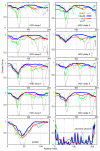Intrinsic disorder and oligomerization of the hepatitis delta virus antigen
- PMID: 20855099
- PMCID: PMC2952689
- DOI: 10.1016/j.virol.2010.08.019
Intrinsic disorder and oligomerization of the hepatitis delta virus antigen
Abstract
The 195 amino acid basic protein (δAg) of hepatitis delta virus (HDV) is essential for replication of the HDV RNA genome. Numerous properties have been mapped to full-length δAg and attempts made to link these to secondary, tertiary and quaternary structures. Here, for the full-size δAg, extensive intrinsic disorder was predicted using PONDR-FIT, a meta-predictor of intrinsic disorder, and evidenced by circular dichroism measurements. Most δAg amino acids are in disordered configurations with no more than 30% adopting an α-helical structure. In addition, dynamic light scattering studies indicated that purified δAg assembled into structures of as large as dodecamers. Cross-linking followed by denaturing polyacrylamide gel electrophoresis revealed hexamers to octamers for this purified δAg and at least this size for δAg found in virus-like particles. Oligomers of purified δAg were resistant to elevated NaCl and urea concentrations, and bound without specificity to RNA and single- and double-stranded DNAs.
Copyright © 2010 Elsevier Inc. All rights reserved.
Figures







Similar articles
-
Interactions between hepatitis delta virus proteins.J Virol. 2000 Jun;74(12):5509-15. doi: 10.1128/jvi.74.12.5509-5515.2000. J Virol. 2000. PMID: 10823856 Free PMC article.
-
Intracellular localization of hepatitis delta virus proteins in the presence and absence of viral RNA accumulation.J Virol. 2009 Jul;83(13):6457-63. doi: 10.1128/JVI.00008-09. Epub 2009 Apr 15. J Virol. 2009. PMID: 19369324 Free PMC article.
-
Parameters of human hepatitis delta virus genome replication: the quantity, quality, and intracellular distribution of viral proteins and RNA.J Virol. 2002 Apr;76(8):3709-19. doi: 10.1128/jvi.76.8.3709-3719.2002. J Virol. 2002. PMID: 11907210 Free PMC article.
-
An update on HDV: virology, pathogenesis and treatment.Antivir Ther. 2013;18(3 Pt B):541-8. doi: 10.3851/IMP2598. Epub 2013 Jun 21. Antivir Ther. 2013. PMID: 23792471 Review.
-
Chapter 3. Replication of the hepatitis delta virus RNA genome.Adv Virus Res. 2009;74:103-21. doi: 10.1016/S0065-3527(09)74003-5. Adv Virus Res. 2009. PMID: 19698896 Review.
Cited by
-
Host RNA circles and the origin of hepatitis delta virus.World J Gastroenterol. 2014 Mar 21;20(11):2971-8. doi: 10.3748/wjg.v20.i11.2971. World J Gastroenterol. 2014. PMID: 24659888 Free PMC article. Review.
-
HDV Can Constrain HBV Genetic Evolution in HBsAg: Implications for the Identification of Innovative Pharmacological Targets.Viruses. 2018 Jul 9;10(7):363. doi: 10.3390/v10070363. Viruses. 2018. PMID: 29987240 Free PMC article.
-
The Intrinsically Disordered Region of HBx and Virus-Host Interactions: Uncovering New Therapeutic Approaches for HBV and Cancer.Int J Mol Sci. 2025 Apr 10;26(8):3552. doi: 10.3390/ijms26083552. Int J Mol Sci. 2025. PMID: 40332052 Free PMC article. Review.
-
Intrinsically disordered regions in the rodent hepevirus proteome.Bioinformation. 2022 Feb 28;18(2):111-118. doi: 10.6026/97320630018111. eCollection 2022. Bioinformation. 2022. PMID: 36420436 Free PMC article.
-
Hepatitis delta virus: A fascinating and neglected pathogen.World J Virol. 2015 Nov 12;4(4):313-22. doi: 10.5501/wjv.v4.i4.313. World J Virol. 2015. PMID: 26568914 Free PMC article. Review.
References
-
- Bergmann KF, Pohl C, Gerin JL. Characterization of proteins of hepatitis delta virus. Prog. Clin. Biol. Res. 1987;234:105–110. - PubMed
-
- Casey JL. Hepatitis delta virus. In: Compans RM, Cooper MD, Honjo T, Koprowski H, Melchers F, Oldstone MBA, Olsnes S, Potter M, Vogt PK, Wagner H, editors. Current Topics in Microbiology and Immunology. Springer; Berlin: 2006.
Publication types
MeSH terms
Substances
Grants and funding
LinkOut - more resources
Full Text Sources

